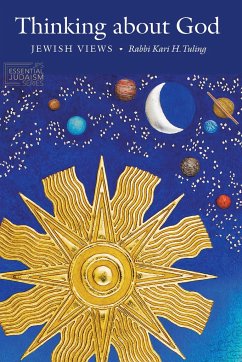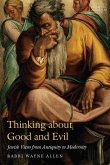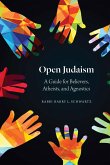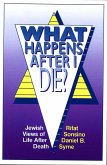Schade – dieser Artikel ist leider ausverkauft. Sobald wir wissen, ob und wann der Artikel wieder verfügbar ist, informieren wir Sie an dieser Stelle.
- Broschiertes Buch
- Merkliste
- Auf die Merkliste
- Bewerten Bewerten
- Teilen
- Produkt teilen
- Produkterinnerung
- Produkterinnerung
Investigating how Jewish thinkers from the biblical to the postmodern era have approached questions about God and highlighting interplays between texts over time, Rabbi Kari H. Tuling elucidates many compelling—and contrasting—ways to think about God in Jewish tradition.
Andere Kunden interessierten sich auch für
![Thinking about Good and Evil Thinking about Good and Evil]() Wayne AllenThinking about Good and Evil29,99 €
Wayne AllenThinking about Good and Evil29,99 €![Open Judaism Open Judaism]() Barry L SchwartzOpen Judaism22,99 €
Barry L SchwartzOpen Judaism22,99 €![The Many Faces of God The Many Faces of God]() Rifat SonsinoThe Many Faces of God16,99 €
Rifat SonsinoThe Many Faces of God16,99 €![Teaching about God and Spirituality Teaching about God and Spirituality]() Behrman HouseTeaching about God and Spirituality37,99 €
Behrman HouseTeaching about God and Spirituality37,99 €![Critical Thinking and the Academic Study of Religion Critical Thinking and the Academic Study of Religion]() Richard PenaskovicCritical Thinking and the Academic Study of Religion26,99 €
Richard PenaskovicCritical Thinking and the Academic Study of Religion26,99 €![What Happens After I Die? Jewish Views of Life After Death What Happens After I Die? Jewish Views of Life After Death]() Behrman HouseWhat Happens After I Die? Jewish Views of Life After Death16,99 €
Behrman HouseWhat Happens After I Die? Jewish Views of Life After Death16,99 €![Historicism, the Holocaust, and Zionism Historicism, the Holocaust, and Zionism]() Steven T KatzHistoricism, the Holocaust, and Zionism34,99 €
Steven T KatzHistoricism, the Holocaust, and Zionism34,99 €-
Investigating how Jewish thinkers from the biblical to the postmodern era have approached questions about God and highlighting interplays between texts over time, Rabbi Kari H. Tuling elucidates many compelling—and contrasting—ways to think about God in Jewish tradition.
Produktdetails
- Produktdetails
- Verlag: Jewish Publication Society
- Seitenzahl: 424
- Erscheinungstermin: 1. August 2020
- Englisch
- Abmessung: 227mm x 152mm x 26mm
- Gewicht: 582g
- ISBN-13: 9780827613010
- ISBN-10: 0827613016
- Artikelnr.: 57975661
- Herstellerkennzeichnung
- Libri GmbH
- Europaallee 1
- 36244 Bad Hersfeld
- gpsr@libri.de
- Verlag: Jewish Publication Society
- Seitenzahl: 424
- Erscheinungstermin: 1. August 2020
- Englisch
- Abmessung: 227mm x 152mm x 26mm
- Gewicht: 582g
- ISBN-13: 9780827613010
- ISBN-10: 0827613016
- Artikelnr.: 57975661
- Herstellerkennzeichnung
- Libri GmbH
- Europaallee 1
- 36244 Bad Hersfeld
- gpsr@libri.de
Rabbi Kari H. Tuling
Acknowledgments
Introduction
Part 1. Is God the Creator and Source of All Being—Including Evil?
1. What Does It Mean to Say That God Created the World?
1.1. A Biblical View: In the Image of God
1.2. From the Liturgy: God Renews Creation Day by Day
1.3. A Rabbinic View: The Trouble with Angels
1.4. A Medieval View: Ibn Pakuda’s Logical Analysis
1.5. A Modern View: Green’s Divine Helpmate
1.6. A Modern View: Kushner’s Sermon
1.7. Summary of Views
1.8. Meaning of the Seven-Day Creation Narrative
1.9. Intended Role of Humanity
2. How Does Evil Exist in a World with a Good God?
2.1. A Biblical View: Romping in the Garden of Eden
2.2. From the Liturgy: The Soul You Have Given Me Is Pure
2.3. A Rabbinic View: The Impulse to Good and the Impulse to Evil
2.4. A Medieval View: Maimonides on Adam’s Sin
2.5. A Modern View: Cohen on God’s Holiness
2.6. A Modern View: Kushner on Bad Things That Happen
2.7. Summary of Views
2.8. The Question of Free Will
2.9. Why Does God Allow Evil to Exist?
Part 2. Does God Have a Personality—or Is God an Impersonal Force?
3. Is God Like a Person?
3.1. A Biblical View: Moses Asks to Behold God’s Presence
3.2. From the Liturgy: Forgiveness and God’s Body
3.3. A Rabbinic View: Where Is God’s Place?
3.4. A Medieval View: Maimonides and the Attributes of Action
3.5. A Modern View: Buber’s Dialogic Approach
3.6. A Modern View: Green’s Non-Dualism
3.7. Summary of Views
3.8. Thinking of God as a Person
3.9. Imagining a Personal God vs. Imagining God as an Impersonal Force
4. Does God Have a Gender?
4.1. A Biblical View: What Does Gender Have to Do with It?
4.2. From the Liturgy: Our Father, Our King
4.3. A Rabbinic View: God’s Fire and the Patriarchy
4.4. A Medieval View: Scholem Explains the Rise of the Shekhinah
4.5. A Modern View: Plaskow’s Feminist Critique
4.6. A Modern View: Adler and the “Pudding Stone”
4.7. A Modern View: Falk’s Poetic Rewrite
4.8. Summary of Views
4.9. Implications of Masculine Images of God
4.10. Rethinking the Meaning of Traditional Texts with Male Imagery
5. What Does It Mean to Declare God Is One?
5.1. A Biblical View: Hear, O Israel
5.2. From the Liturgy: The Shema and Its Blessings
5.3. A Rabbinic View: A Deathbed Shema
5.4. A Medieval View: Maimonides’ Meditation
5.5. A Modern View: Schneerson’s Explicit Mysticism
5.6. A Modern View: Soloveitchik Is Ever the Rationalist
5.7. A Modern View: Schachter-Shalomi’s Embodied Prayer
5.8. Summary of Views
5.9. The Meaning of Bearing Witness to God’s Oneness
5.10. Praying as One (Community)
Part 3. Does God Redeem—or Might God Not Redeem?
6. Does God Intervene in Our Lives?
6.1. A Biblical View: Hannah Prays for a Son
6.2. From the Liturgy: A Tkhines for Pregnancy
6.3. A Rabbinic View: Hannah Persuades God to Act
6.4. A Medieval View: Ibn Pakuda Argues for Predetermination
6.5. A Modern View: Heschel’s Partnership with God
6.6. A Modern View: Kaplan’s Rejection of Supernaturalism
6.7. Summary of Views
6.8. Does God Act on Behalf of the Jewish Community?
6.9. Is the Creation of the State of Israel Evidence of Divine Providence?
7. Does God Intervene in History?
7.1. A Biblical View: What Was Meant for Evil, God Meant for Good
7.2. From the Liturgy: The Martyrdom of Jewish Sages
7.3. A Rabbinic View: Why Does Suffering Happen?
7.4. A Medieval View: Meir ben Baruch Memorializes the Talmud
7.5. A Modern View: Cohen and the Suffering Servant
7.6. A Modern View: Rubenstein and the Death of God
7.7. A Modern View: Jonas Offers a New Mythic Structure
7.8. A Modern View: Greenberg Senses God’s Suffering
7.9. Summary of Views
7.10. Why Was God Silent during the Holocaust?
7.11. Suffering and the Human-God Relationship
Part 4. Is God a Covenantal Partner and Lawgiver—or Might These Roles Be
Rethought in the Modern Age?
8. What is the Relationship between God and Israel?
8.1. A Biblical View: Enacting a Covenant
8.2. From the Liturgy: Shabbat Reenacts the Covenant
8.3. A Rabbinic View: Where Is the Evidence of God’s Love?
8.4. A Medieval View: Halevi’s Defense of the “Despised Faith”
8.5. A Modern View: Soloveitchik’s Mathematical Approach
8.6. A Modern View: Borowitz’s Metaphorical Covenant
8.7. A Modern View: Fishbane’s Hermeneutical Theology
8.8. A Modern View: Hartman’s “Autoimmune Disease”
8.9. Summary of Views
8.10. Meaning of Enacting the Covenant
8.11. Covenant as Metaphor
9. Is It a Binding Covenant?
9.1. A Biblical View: Preparing for Revelation
9.2. From the Liturgy: With Great Love
9.3. A Rabbinic View: God Holds Sinai over Their Heads
9.4. A Medieval View: Ibn Pakuda and the Duty to Obey
9.5. A Modern View: Rosenzweig’s Universal Love
9.6. A Modern View: Novak’s Concern for Human Rights
9.7. Summary of Views
9.8. Is the Covenant Binding if the Bible Was Not Revealed by God?
9.9. Existing Peacefully in a Pluralistic World
10. How Should the Revealed Law Be Understood?
10.1. A Biblical View: It Is Not in Heaven
10.2. From the Liturgy: This Is the Torah
10.3. A Rabbinic View: Halakhah according to the Rabbinic Majority
10.4. A Medieval View: Saadia on Why Prophecy Is Needed
10.5. A Modern View: Steinberg on Who Is Fit to Interpret Revealed Law
10.6. A Modern View: Heschel’s Understanding of Revelation
10.7. Summary of Views
10.8. Accounting for the Rise of Literalism
10.9. Reimagining a Foundational Document
Conclusion
Notes
Bibliography
Index
Introduction
Part 1. Is God the Creator and Source of All Being—Including Evil?
1. What Does It Mean to Say That God Created the World?
1.1. A Biblical View: In the Image of God
1.2. From the Liturgy: God Renews Creation Day by Day
1.3. A Rabbinic View: The Trouble with Angels
1.4. A Medieval View: Ibn Pakuda’s Logical Analysis
1.5. A Modern View: Green’s Divine Helpmate
1.6. A Modern View: Kushner’s Sermon
1.7. Summary of Views
1.8. Meaning of the Seven-Day Creation Narrative
1.9. Intended Role of Humanity
2. How Does Evil Exist in a World with a Good God?
2.1. A Biblical View: Romping in the Garden of Eden
2.2. From the Liturgy: The Soul You Have Given Me Is Pure
2.3. A Rabbinic View: The Impulse to Good and the Impulse to Evil
2.4. A Medieval View: Maimonides on Adam’s Sin
2.5. A Modern View: Cohen on God’s Holiness
2.6. A Modern View: Kushner on Bad Things That Happen
2.7. Summary of Views
2.8. The Question of Free Will
2.9. Why Does God Allow Evil to Exist?
Part 2. Does God Have a Personality—or Is God an Impersonal Force?
3. Is God Like a Person?
3.1. A Biblical View: Moses Asks to Behold God’s Presence
3.2. From the Liturgy: Forgiveness and God’s Body
3.3. A Rabbinic View: Where Is God’s Place?
3.4. A Medieval View: Maimonides and the Attributes of Action
3.5. A Modern View: Buber’s Dialogic Approach
3.6. A Modern View: Green’s Non-Dualism
3.7. Summary of Views
3.8. Thinking of God as a Person
3.9. Imagining a Personal God vs. Imagining God as an Impersonal Force
4. Does God Have a Gender?
4.1. A Biblical View: What Does Gender Have to Do with It?
4.2. From the Liturgy: Our Father, Our King
4.3. A Rabbinic View: God’s Fire and the Patriarchy
4.4. A Medieval View: Scholem Explains the Rise of the Shekhinah
4.5. A Modern View: Plaskow’s Feminist Critique
4.6. A Modern View: Adler and the “Pudding Stone”
4.7. A Modern View: Falk’s Poetic Rewrite
4.8. Summary of Views
4.9. Implications of Masculine Images of God
4.10. Rethinking the Meaning of Traditional Texts with Male Imagery
5. What Does It Mean to Declare God Is One?
5.1. A Biblical View: Hear, O Israel
5.2. From the Liturgy: The Shema and Its Blessings
5.3. A Rabbinic View: A Deathbed Shema
5.4. A Medieval View: Maimonides’ Meditation
5.5. A Modern View: Schneerson’s Explicit Mysticism
5.6. A Modern View: Soloveitchik Is Ever the Rationalist
5.7. A Modern View: Schachter-Shalomi’s Embodied Prayer
5.8. Summary of Views
5.9. The Meaning of Bearing Witness to God’s Oneness
5.10. Praying as One (Community)
Part 3. Does God Redeem—or Might God Not Redeem?
6. Does God Intervene in Our Lives?
6.1. A Biblical View: Hannah Prays for a Son
6.2. From the Liturgy: A Tkhines for Pregnancy
6.3. A Rabbinic View: Hannah Persuades God to Act
6.4. A Medieval View: Ibn Pakuda Argues for Predetermination
6.5. A Modern View: Heschel’s Partnership with God
6.6. A Modern View: Kaplan’s Rejection of Supernaturalism
6.7. Summary of Views
6.8. Does God Act on Behalf of the Jewish Community?
6.9. Is the Creation of the State of Israel Evidence of Divine Providence?
7. Does God Intervene in History?
7.1. A Biblical View: What Was Meant for Evil, God Meant for Good
7.2. From the Liturgy: The Martyrdom of Jewish Sages
7.3. A Rabbinic View: Why Does Suffering Happen?
7.4. A Medieval View: Meir ben Baruch Memorializes the Talmud
7.5. A Modern View: Cohen and the Suffering Servant
7.6. A Modern View: Rubenstein and the Death of God
7.7. A Modern View: Jonas Offers a New Mythic Structure
7.8. A Modern View: Greenberg Senses God’s Suffering
7.9. Summary of Views
7.10. Why Was God Silent during the Holocaust?
7.11. Suffering and the Human-God Relationship
Part 4. Is God a Covenantal Partner and Lawgiver—or Might These Roles Be
Rethought in the Modern Age?
8. What is the Relationship between God and Israel?
8.1. A Biblical View: Enacting a Covenant
8.2. From the Liturgy: Shabbat Reenacts the Covenant
8.3. A Rabbinic View: Where Is the Evidence of God’s Love?
8.4. A Medieval View: Halevi’s Defense of the “Despised Faith”
8.5. A Modern View: Soloveitchik’s Mathematical Approach
8.6. A Modern View: Borowitz’s Metaphorical Covenant
8.7. A Modern View: Fishbane’s Hermeneutical Theology
8.8. A Modern View: Hartman’s “Autoimmune Disease”
8.9. Summary of Views
8.10. Meaning of Enacting the Covenant
8.11. Covenant as Metaphor
9. Is It a Binding Covenant?
9.1. A Biblical View: Preparing for Revelation
9.2. From the Liturgy: With Great Love
9.3. A Rabbinic View: God Holds Sinai over Their Heads
9.4. A Medieval View: Ibn Pakuda and the Duty to Obey
9.5. A Modern View: Rosenzweig’s Universal Love
9.6. A Modern View: Novak’s Concern for Human Rights
9.7. Summary of Views
9.8. Is the Covenant Binding if the Bible Was Not Revealed by God?
9.9. Existing Peacefully in a Pluralistic World
10. How Should the Revealed Law Be Understood?
10.1. A Biblical View: It Is Not in Heaven
10.2. From the Liturgy: This Is the Torah
10.3. A Rabbinic View: Halakhah according to the Rabbinic Majority
10.4. A Medieval View: Saadia on Why Prophecy Is Needed
10.5. A Modern View: Steinberg on Who Is Fit to Interpret Revealed Law
10.6. A Modern View: Heschel’s Understanding of Revelation
10.7. Summary of Views
10.8. Accounting for the Rise of Literalism
10.9. Reimagining a Foundational Document
Conclusion
Notes
Bibliography
Index
Acknowledgments
Introduction
Part 1. Is God the Creator and Source of All Being—Including Evil?
1. What Does It Mean to Say That God Created the World?
1.1. A Biblical View: In the Image of God
1.2. From the Liturgy: God Renews Creation Day by Day
1.3. A Rabbinic View: The Trouble with Angels
1.4. A Medieval View: Ibn Pakuda’s Logical Analysis
1.5. A Modern View: Green’s Divine Helpmate
1.6. A Modern View: Kushner’s Sermon
1.7. Summary of Views
1.8. Meaning of the Seven-Day Creation Narrative
1.9. Intended Role of Humanity
2. How Does Evil Exist in a World with a Good God?
2.1. A Biblical View: Romping in the Garden of Eden
2.2. From the Liturgy: The Soul You Have Given Me Is Pure
2.3. A Rabbinic View: The Impulse to Good and the Impulse to Evil
2.4. A Medieval View: Maimonides on Adam’s Sin
2.5. A Modern View: Cohen on God’s Holiness
2.6. A Modern View: Kushner on Bad Things That Happen
2.7. Summary of Views
2.8. The Question of Free Will
2.9. Why Does God Allow Evil to Exist?
Part 2. Does God Have a Personality—or Is God an Impersonal Force?
3. Is God Like a Person?
3.1. A Biblical View: Moses Asks to Behold God’s Presence
3.2. From the Liturgy: Forgiveness and God’s Body
3.3. A Rabbinic View: Where Is God’s Place?
3.4. A Medieval View: Maimonides and the Attributes of Action
3.5. A Modern View: Buber’s Dialogic Approach
3.6. A Modern View: Green’s Non-Dualism
3.7. Summary of Views
3.8. Thinking of God as a Person
3.9. Imagining a Personal God vs. Imagining God as an Impersonal Force
4. Does God Have a Gender?
4.1. A Biblical View: What Does Gender Have to Do with It?
4.2. From the Liturgy: Our Father, Our King
4.3. A Rabbinic View: God’s Fire and the Patriarchy
4.4. A Medieval View: Scholem Explains the Rise of the Shekhinah
4.5. A Modern View: Plaskow’s Feminist Critique
4.6. A Modern View: Adler and the “Pudding Stone”
4.7. A Modern View: Falk’s Poetic Rewrite
4.8. Summary of Views
4.9. Implications of Masculine Images of God
4.10. Rethinking the Meaning of Traditional Texts with Male Imagery
5. What Does It Mean to Declare God Is One?
5.1. A Biblical View: Hear, O Israel
5.2. From the Liturgy: The Shema and Its Blessings
5.3. A Rabbinic View: A Deathbed Shema
5.4. A Medieval View: Maimonides’ Meditation
5.5. A Modern View: Schneerson’s Explicit Mysticism
5.6. A Modern View: Soloveitchik Is Ever the Rationalist
5.7. A Modern View: Schachter-Shalomi’s Embodied Prayer
5.8. Summary of Views
5.9. The Meaning of Bearing Witness to God’s Oneness
5.10. Praying as One (Community)
Part 3. Does God Redeem—or Might God Not Redeem?
6. Does God Intervene in Our Lives?
6.1. A Biblical View: Hannah Prays for a Son
6.2. From the Liturgy: A Tkhines for Pregnancy
6.3. A Rabbinic View: Hannah Persuades God to Act
6.4. A Medieval View: Ibn Pakuda Argues for Predetermination
6.5. A Modern View: Heschel’s Partnership with God
6.6. A Modern View: Kaplan’s Rejection of Supernaturalism
6.7. Summary of Views
6.8. Does God Act on Behalf of the Jewish Community?
6.9. Is the Creation of the State of Israel Evidence of Divine Providence?
7. Does God Intervene in History?
7.1. A Biblical View: What Was Meant for Evil, God Meant for Good
7.2. From the Liturgy: The Martyrdom of Jewish Sages
7.3. A Rabbinic View: Why Does Suffering Happen?
7.4. A Medieval View: Meir ben Baruch Memorializes the Talmud
7.5. A Modern View: Cohen and the Suffering Servant
7.6. A Modern View: Rubenstein and the Death of God
7.7. A Modern View: Jonas Offers a New Mythic Structure
7.8. A Modern View: Greenberg Senses God’s Suffering
7.9. Summary of Views
7.10. Why Was God Silent during the Holocaust?
7.11. Suffering and the Human-God Relationship
Part 4. Is God a Covenantal Partner and Lawgiver—or Might These Roles Be
Rethought in the Modern Age?
8. What is the Relationship between God and Israel?
8.1. A Biblical View: Enacting a Covenant
8.2. From the Liturgy: Shabbat Reenacts the Covenant
8.3. A Rabbinic View: Where Is the Evidence of God’s Love?
8.4. A Medieval View: Halevi’s Defense of the “Despised Faith”
8.5. A Modern View: Soloveitchik’s Mathematical Approach
8.6. A Modern View: Borowitz’s Metaphorical Covenant
8.7. A Modern View: Fishbane’s Hermeneutical Theology
8.8. A Modern View: Hartman’s “Autoimmune Disease”
8.9. Summary of Views
8.10. Meaning of Enacting the Covenant
8.11. Covenant as Metaphor
9. Is It a Binding Covenant?
9.1. A Biblical View: Preparing for Revelation
9.2. From the Liturgy: With Great Love
9.3. A Rabbinic View: God Holds Sinai over Their Heads
9.4. A Medieval View: Ibn Pakuda and the Duty to Obey
9.5. A Modern View: Rosenzweig’s Universal Love
9.6. A Modern View: Novak’s Concern for Human Rights
9.7. Summary of Views
9.8. Is the Covenant Binding if the Bible Was Not Revealed by God?
9.9. Existing Peacefully in a Pluralistic World
10. How Should the Revealed Law Be Understood?
10.1. A Biblical View: It Is Not in Heaven
10.2. From the Liturgy: This Is the Torah
10.3. A Rabbinic View: Halakhah according to the Rabbinic Majority
10.4. A Medieval View: Saadia on Why Prophecy Is Needed
10.5. A Modern View: Steinberg on Who Is Fit to Interpret Revealed Law
10.6. A Modern View: Heschel’s Understanding of Revelation
10.7. Summary of Views
10.8. Accounting for the Rise of Literalism
10.9. Reimagining a Foundational Document
Conclusion
Notes
Bibliography
Index
Introduction
Part 1. Is God the Creator and Source of All Being—Including Evil?
1. What Does It Mean to Say That God Created the World?
1.1. A Biblical View: In the Image of God
1.2. From the Liturgy: God Renews Creation Day by Day
1.3. A Rabbinic View: The Trouble with Angels
1.4. A Medieval View: Ibn Pakuda’s Logical Analysis
1.5. A Modern View: Green’s Divine Helpmate
1.6. A Modern View: Kushner’s Sermon
1.7. Summary of Views
1.8. Meaning of the Seven-Day Creation Narrative
1.9. Intended Role of Humanity
2. How Does Evil Exist in a World with a Good God?
2.1. A Biblical View: Romping in the Garden of Eden
2.2. From the Liturgy: The Soul You Have Given Me Is Pure
2.3. A Rabbinic View: The Impulse to Good and the Impulse to Evil
2.4. A Medieval View: Maimonides on Adam’s Sin
2.5. A Modern View: Cohen on God’s Holiness
2.6. A Modern View: Kushner on Bad Things That Happen
2.7. Summary of Views
2.8. The Question of Free Will
2.9. Why Does God Allow Evil to Exist?
Part 2. Does God Have a Personality—or Is God an Impersonal Force?
3. Is God Like a Person?
3.1. A Biblical View: Moses Asks to Behold God’s Presence
3.2. From the Liturgy: Forgiveness and God’s Body
3.3. A Rabbinic View: Where Is God’s Place?
3.4. A Medieval View: Maimonides and the Attributes of Action
3.5. A Modern View: Buber’s Dialogic Approach
3.6. A Modern View: Green’s Non-Dualism
3.7. Summary of Views
3.8. Thinking of God as a Person
3.9. Imagining a Personal God vs. Imagining God as an Impersonal Force
4. Does God Have a Gender?
4.1. A Biblical View: What Does Gender Have to Do with It?
4.2. From the Liturgy: Our Father, Our King
4.3. A Rabbinic View: God’s Fire and the Patriarchy
4.4. A Medieval View: Scholem Explains the Rise of the Shekhinah
4.5. A Modern View: Plaskow’s Feminist Critique
4.6. A Modern View: Adler and the “Pudding Stone”
4.7. A Modern View: Falk’s Poetic Rewrite
4.8. Summary of Views
4.9. Implications of Masculine Images of God
4.10. Rethinking the Meaning of Traditional Texts with Male Imagery
5. What Does It Mean to Declare God Is One?
5.1. A Biblical View: Hear, O Israel
5.2. From the Liturgy: The Shema and Its Blessings
5.3. A Rabbinic View: A Deathbed Shema
5.4. A Medieval View: Maimonides’ Meditation
5.5. A Modern View: Schneerson’s Explicit Mysticism
5.6. A Modern View: Soloveitchik Is Ever the Rationalist
5.7. A Modern View: Schachter-Shalomi’s Embodied Prayer
5.8. Summary of Views
5.9. The Meaning of Bearing Witness to God’s Oneness
5.10. Praying as One (Community)
Part 3. Does God Redeem—or Might God Not Redeem?
6. Does God Intervene in Our Lives?
6.1. A Biblical View: Hannah Prays for a Son
6.2. From the Liturgy: A Tkhines for Pregnancy
6.3. A Rabbinic View: Hannah Persuades God to Act
6.4. A Medieval View: Ibn Pakuda Argues for Predetermination
6.5. A Modern View: Heschel’s Partnership with God
6.6. A Modern View: Kaplan’s Rejection of Supernaturalism
6.7. Summary of Views
6.8. Does God Act on Behalf of the Jewish Community?
6.9. Is the Creation of the State of Israel Evidence of Divine Providence?
7. Does God Intervene in History?
7.1. A Biblical View: What Was Meant for Evil, God Meant for Good
7.2. From the Liturgy: The Martyrdom of Jewish Sages
7.3. A Rabbinic View: Why Does Suffering Happen?
7.4. A Medieval View: Meir ben Baruch Memorializes the Talmud
7.5. A Modern View: Cohen and the Suffering Servant
7.6. A Modern View: Rubenstein and the Death of God
7.7. A Modern View: Jonas Offers a New Mythic Structure
7.8. A Modern View: Greenberg Senses God’s Suffering
7.9. Summary of Views
7.10. Why Was God Silent during the Holocaust?
7.11. Suffering and the Human-God Relationship
Part 4. Is God a Covenantal Partner and Lawgiver—or Might These Roles Be
Rethought in the Modern Age?
8. What is the Relationship between God and Israel?
8.1. A Biblical View: Enacting a Covenant
8.2. From the Liturgy: Shabbat Reenacts the Covenant
8.3. A Rabbinic View: Where Is the Evidence of God’s Love?
8.4. A Medieval View: Halevi’s Defense of the “Despised Faith”
8.5. A Modern View: Soloveitchik’s Mathematical Approach
8.6. A Modern View: Borowitz’s Metaphorical Covenant
8.7. A Modern View: Fishbane’s Hermeneutical Theology
8.8. A Modern View: Hartman’s “Autoimmune Disease”
8.9. Summary of Views
8.10. Meaning of Enacting the Covenant
8.11. Covenant as Metaphor
9. Is It a Binding Covenant?
9.1. A Biblical View: Preparing for Revelation
9.2. From the Liturgy: With Great Love
9.3. A Rabbinic View: God Holds Sinai over Their Heads
9.4. A Medieval View: Ibn Pakuda and the Duty to Obey
9.5. A Modern View: Rosenzweig’s Universal Love
9.6. A Modern View: Novak’s Concern for Human Rights
9.7. Summary of Views
9.8. Is the Covenant Binding if the Bible Was Not Revealed by God?
9.9. Existing Peacefully in a Pluralistic World
10. How Should the Revealed Law Be Understood?
10.1. A Biblical View: It Is Not in Heaven
10.2. From the Liturgy: This Is the Torah
10.3. A Rabbinic View: Halakhah according to the Rabbinic Majority
10.4. A Medieval View: Saadia on Why Prophecy Is Needed
10.5. A Modern View: Steinberg on Who Is Fit to Interpret Revealed Law
10.6. A Modern View: Heschel’s Understanding of Revelation
10.7. Summary of Views
10.8. Accounting for the Rise of Literalism
10.9. Reimagining a Foundational Document
Conclusion
Notes
Bibliography
Index








